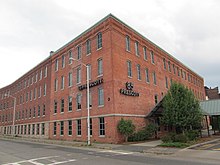Massachusetts Academy of Math and Science at WPI
| Massachusetts Academy of Math and Science at WPI | |
|---|---|
 |
|
| Address | |
|
85 Prescott Street Worcester, Massachusetts United States |
|
| Coordinates | 42°17′18.55″N 71°47′59.19″W / 42.2884861°N 71.7997750°W |
| Information | |
| Type | Public Magnet |
| Established | 1992 |
| Founder | Arthur E. Chase |
| Director | Michael Barney |
| Grades | 11 - 12 |
| Number of students | approx. 100 |
| Color(s) | maroon and gray |
| Average SAT scores | 703 verbal 741 math 688 writing 2132 total (2015-2016) |
| Website | massacademy.org |
Located in Worcester, Massachusetts, the Massachusetts Academy of Math and Science at WPI (Mass Academy/MAMS/MAMAS) was founded in 1992 by the Massachusetts State Legislature as a public, non-residential magnet school to serve academically advanced youth in grades eleven and twelve in math, science, and technology.
The school emphasizes math and science within a comprehensive, interactive program. The rigor of the junior year classes exceeds high school honors and AP, with more than 1200 hours of instruction. Seniors complete a year of college, taking the same classes as other students at Worcester Polytechnic Institute. WPI is a nationally ranked engineering school, thus making the Academy the only public school in Massachusetts whose students attend a university full-time as seniors in high school. The Academy was originally located in the sub-basement of WPI's library, but is now located nearby at 85 Prescott Street, near the WPI bioengineering complex.
The Academy is a collaborative effort among the Commonwealth of Massachusetts, Worcester Polytechnic Institute, and the high schools of Massachusetts. In addition to passing all classes, the Academy also requires that all students complete 50 hours of community service per year.
Students who want to attend the Academy must apply in the sophomore year of high school, although some exceptions have been made. For example, an occasional freshmen has entered the Academy in what would have been his/her sophomore year at their "sending" school. Othertimes, high school juniors have elected to repeat their eleventh grade at the Academy.
The admissions process is very selective. Grades, teacher recommendations, personal essay, and the academy exam serve as the primary indicators of student ability and motivation.
In 1992, the requirements for entry into the academy required a minimum of 1 years advanced in math and/or science and 2 years ahead in one of the subjects. The admissions process has been changed to the above so this is no longer required; however, only 1/6 of the self-selected group of applicants are offered admission.
The Academy encourages students who wish to attend to visit the school for a day. These visitors, called "shadows," follow a host student so as to experience a typical day.
Junior year students attend classes from 7:45 a.m. until 2:45 p.m, followed by extracurricular activities until 4 PM. Mandatory classes include Mathematical Modeling, Physics, Humanities, Computer Science, STEM (Science Technology Engineering and Math), Science and Technical Writing, and Foreign Language. STEM I is a class in which students take on an original research investigation that makes some contribution in that field. Students can either conduct science, math or engineering projects. This class culminates with a science fair in February. STEM II is an engineering class in which students work in three- and four-person teams to develop a piece of assistive technology. These projects are designed with a specific client in mind, usually a young student with a physical handicap. The foreign language classes are also different from most schools. In addition to grammar and translation, the class period consists of making a movie completely in either Spanish or French, singing songs written in foreign language, and discussion in the target language. Two days a week after school students participate in 1.5 hour elective periods, where students can take a class of their choosing. The electives offered each term differ, but have included social dancing, cooking, machine shop, bowling, film appreciation, water colors, photography, advanced mathematics, mock trial, speech and debate, FIRST Robotics, kickboxing, puzzles, German, and drama.
...
Wikipedia
